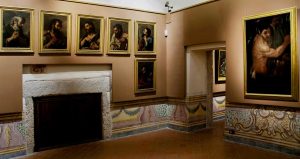Venafro, a town in the province of Isernia, is the fourth largest city in the region by population and is located in western Molise on the border of the Lazio and Campania regions.
Venafro has very ancient origins that date back to the Samnites. The Samnites were an Italic people who fought against Rome during the III century B.C. in the Samnite Wars. In 89 B.C., Venafrum was the scene of a decisive battle between the peoples of the Italic League and Rome in the so-called Social War. In the Middle Ages it was invaded by the Lombards. From the sixth century, it became home to a diocese and an important passage from Molise and Abruzzo to Naples. Beginning in the fifteenth century it was owned by the Pandone family, which contributed to the economic recovery of the center. In 1860 the castle also hosted Vittorio Emanuele II while traveling to meet with Giuseppe Garibaldi.

The historic center looks like a fortified village along the slope of the mountain, far from the ancient Roman center, identified in the area of the amphitheater. The highest point of the village is the Pandone Castle, while the cathedral, following the outline of the ancient Norman-Longobard cities, is located outside the walls. The urban structure is very precise, marked by thistle and decumanus, and is influenced by the architectural influence of the Neapolitan baroque period.
The first nucleus of the castle is a megalithic structure, whose remains are visible at the base of the Longobardo mastio. The development of the fortified complex occurred in the second half of the tenth century, and thanks to the Lombard count Paldefredo and his successors, the fortress was built with the elevation of a quadrangular enclosure with at least two towers. With the advent of the Normans, the castle and the village suffered considerable damage due to the troops of King Roger II of Altavilla. During the Angevin period, a moat and the three large circular towers with a truncated conical base were added.
In 1443, with the Aragonese, the castle passed to the Pandone family. Count Francesco commissioned the expansion of the moat and the construction of a crenellated embankment. At the beginning of the sixteenth century Henry III transformed the structure into a residence, making the gallery, the garden and the paintings (1522-1527 ) depicting the best horses of his famous breeding. The technique used for the representations is that of stiacciato, a plaster with a low-relief figure on which to place the color. Each horse painting shows the horse’s age, breed, name, color of the mantle and the symbol H (Henricus stable).

Inside you can still admire a fourteenth-century staircase, the main floor, the so-called “Racing horses” gallery, a loggia with arcades and the Hall of the Horse by Charles V which were a symbol of gratitude given to the emperor by Henry Pandone for having appointed Count Enrico Duke of Boiano. Finally, a lovely garden completes the visit of the interior of the Castle.
Inside the castle are works of art originating from: the Molise region, the state, the Museums of Capodimonte and San Martino of Naples, the National Gallery of Ancient Art in Rome and the Royal Palace of Caserta.

The visit is divided into two parts: the castle, with its urban, architectural and decorative values; and the exhibition on the second floor of frescoes, sculptures, paintings, drawings and prints, in an itinerary that documents the chronology (from the Middle Ages to the Baroque ) and the different cultural orientations of clients and artists in Molise. For more information visit the castle’s website in English at: Pandone Castle
photo copyrights: castellopandone.beniculturali.it

